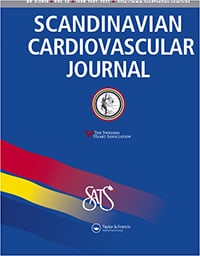Electrocardiographic changes in the differentiation of ischemic and non-ischemic ST elevation

Objectives
Pericarditis, takotsubo cardiomyopathy and early repolarization syndrome (ERS) are well-known to mimic ST elevation myocardial infarction (STEMI). We aimed to study whether ECG findings of reciprocal ST depression, PR depression, ST-segment convexity or terminal QRS distortion can discriminate between ST elevation due to ischemia and non-ischemic conditions.Design
Eighty-five patients with STEMI and 94 patients with non-ischemic ST elevation were included. All patients had acute chest pain and at least 0.1 mV ST elevation. Presence of PR depression, ST-segment convexity, terminal QRS distortion or reciprocal ST depression was assessed in each ECG.Results
In anterior ST elevation, ST depression in lead II (≥0.025 mV) occurred in 40% of patients with STEMI but in none of the non-ischemic cases. In inferior ST elevation, ST depression in lead I (≥0.025 mV) was present in 83% of patients with STEMI but in none of the non-ischemic cases. Chest-lead PR depression was uncommon in STEMI (12%) compared to non-ischemic cases (38%; p < .001). Convex ST elevation occurred in 22% of STEMI cases and in 9% of non-ischemic cases (p = .01). Terminal QRS distortion was more prevalent in STEMI (40%) than in non-ischemic ST elevation (7%). In multivariable analysis, reciprocal ST depression was associated with an ischemic diagnosis, whereas ST depression in aVR and chest-lead PR depression were associated with a non-ischemic diagnosis.Conclusions
Identification of true STEMI among patients with different ST-elevation etiology may be improved by considering reciprocal ST depression, ST depression in aVR and chest-lead PR depression.
Thomas Lindow, Olle Pahlm, Ardavan Khoshnood, Ingvar Nyman, Daniel Manna, Henrik Engblom, Annmarie Touborg Lassen, Ulf Ekelund
2019
Scandinavian Cardiovascular Journal, 54(2):100-107
